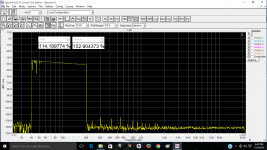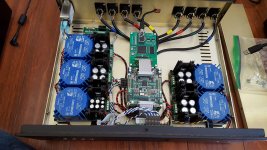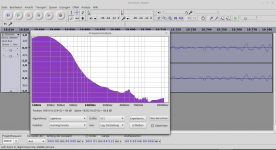I have a es9018 based multichannel DAC connected to Hypex Ncore400 and UcD400 amps. The interconnection is balanced.
This is used in a DSP active 4way
I notice strange scratchy, crackling, distortion almost modulating with the music, when i just play the bass channels with mid/tweeter muted.
Bass is two seas excel W22 8" drivers in parallel for a 4ohm load.
Bass is bandpassed in the range 60Hz to 300Hz using LR4 slopes.
I do notice the same distortion with all my DSP bypassed and running some bass tones directly from another software player. So this is not an issue with the DSP.
The DAC itself measures clean in distortion checks using a spectrum analyzer.
But replacing the DAC with a motu/focusrite DAC in the same configuration gets rid of the distortion.
Here are some samples.
https://drive.google.com/open?id=0B7X-dOhSii2xYUowV21JeU5BSWM
The distortion/noise seems to be some higher frequency components as they are audible only on-axis with the drivers. They are audible at nominal listening levels even from about 1m straight in front of the drivers.
Please give them a listen and advice.
This is used in a DSP active 4way
I notice strange scratchy, crackling, distortion almost modulating with the music, when i just play the bass channels with mid/tweeter muted.
Bass is two seas excel W22 8" drivers in parallel for a 4ohm load.
Bass is bandpassed in the range 60Hz to 300Hz using LR4 slopes.
I do notice the same distortion with all my DSP bypassed and running some bass tones directly from another software player. So this is not an issue with the DSP.
The DAC itself measures clean in distortion checks using a spectrum analyzer.
But replacing the DAC with a motu/focusrite DAC in the same configuration gets rid of the distortion.
Here are some samples.
https://drive.google.com/open?id=0B7X-dOhSii2xYUowV21JeU5BSWM
The distortion/noise seems to be some higher frequency components as they are audible only on-axis with the drivers. They are audible at nominal listening levels even from about 1m straight in front of the drivers.
Please give them a listen and advice.
Last edited:
Do you have a passive speaker or a headphone amp that you can listen to the individual channels of the ES9018 to see if they are all affected the same way if used with full range signals?
Are you able to use ARTA or rightmark to see what is coming out of the DAC when you play a test tone?
If you can do either of those it will probably help to narrow down what the issue could be.
Are you able to use ARTA or rightmark to see what is coming out of the DAC when you play a test tone?
If you can do either of those it will probably help to narrow down what the issue could be.
Thanks Fluid.
Its not audible in presence of full range signal.
Headphone amp is a good suggestion, i dont have one, but will try to get that tested.
When tested on Spectraplus with a EMU0404 USB soundcard, the distortions seem to be below -100db
Its not audible in presence of full range signal.
Headphone amp is a good suggestion, i dont have one, but will try to get that tested.
When tested on Spectraplus with a EMU0404 USB soundcard, the distortions seem to be below -100db
Strange that the distortion is not audible with a full range signal perhaps it is an interaction between the DSP processing and the DAC.
When you say full range signal how are you testing that? If you can use two channels of the DAC to a separate pair of passive speakers or headphone amp and have no issues then you have eliminated the DAC as being inherently faulty.
Any distortion at -100dB would be very difficult to hear at all. What I hear in your videos sounds much louder than that.
It sounds as if something is being clipped slightly, are you able to monitor the gains throughout your signal chain in some way?
Try some test tones at different frequencies through spectraplus it may be that one frequency in particular is resonating or clipping, it is hard to isolate with music as a test signal.
When you say full range signal how are you testing that? If you can use two channels of the DAC to a separate pair of passive speakers or headphone amp and have no issues then you have eliminated the DAC as being inherently faulty.
Any distortion at -100dB would be very difficult to hear at all. What I hear in your videos sounds much louder than that.
It sounds as if something is being clipped slightly, are you able to monitor the gains throughout your signal chain in some way?
Try some test tones at different frequencies through spectraplus it may be that one frequency in particular is resonating or clipping, it is hard to isolate with music as a test signal.
Last edited:
fluid
It is unlikely a DSP issue.
I tested the DAC with everything in the chain completely bypassed. That is no DSP no Jriver and the distortion is still present.
For example i tired REW output directly though the DAC driver and i reproduced the issue.
In full range i think the distortion is hidden away by mid/tweeter sound. Carefully listening close to the bass driver still reveals the distortion being present.
could you explain the clipping thought.
This sounds like some high freq noise getting modulated by the music.
Fluid, with a passive speaker, I think the noise will get filtered out by the LP on the bass driver. It is not really audible mixed with mid/tweeter.
It is unlikely a DSP issue.
I tested the DAC with everything in the chain completely bypassed. That is no DSP no Jriver and the distortion is still present.
For example i tired REW output directly though the DAC driver and i reproduced the issue.
In full range i think the distortion is hidden away by mid/tweeter sound. Carefully listening close to the bass driver still reveals the distortion being present.
could you explain the clipping thought.
This sounds like some high freq noise getting modulated by the music.
Fluid, with a passive speaker, I think the noise will get filtered out by the LP on the bass driver. It is not really audible mixed with mid/tweeter.
Everything currently points to the DAC as a Motu and Foucsrite DAC in the same system doesnt produce the distortion.
Its not audible in presence of full range signal.
Maybe I misunderstood what you wrote before.
To me the only way to test if the DAC alone has the issue is to isolate it. Use it just by itself straight from your source into an amplifier and into a speaker. If you have a passive speaker or headphone setup that makes it easier if not then use the speaker that covers the widest range which may be your mid driver.
If you get the same distortion then you know the issue is coming from the DAC. Run some test tones through the DAC and see what comes out, that will help to identify what is being distorted.
I don't see how high frequency noise would be modulated by the music signal. When the distortion coincides with a musical event it is often that a peak in the music is causing clipping or overloading somewhere in the chain.
When using DSP there is opportunity to cut and boost and sometimes this can cause one of the stages to clip. If you have completely bypassed any processing then you should be able to rule that out as a cause.
Digital clipping is a very horrible crunching noise which does not sound like your video. I have a DSP based active system and have heard the DSP clipping it is fairly unmistakeable, your's sounds more analogue in nature.
Depending on the voltage output of the DAC it could be causing clipping in your amp although that would likely make it very loud. Without knowing more about the equipment you are using it is hard to guess what might be going wrong.
Is the DAC a commercial unit or DIY? Has it ever worked properly just as a stereo DAC or is this the first time you are testing?
Fluid, with a passive speaker, I think the noise will get filtered out by the LP on the bass driver. It is not really audible mixed with mid/tweeter.
If the noise is being generated or passed by the DAC then it will be reproduced by the tweeter in a normal passive two way speaker. The noise may be masked when you have the mid and tweeter running in your active system.
If the DAC is causing distortion or noise then you should be able to hear it when used with a basic passive speaker or set of headphones.
I see what you mean. But playing full range into a single driver will very likely make it very difficult to make out any distortion in the presence of real high freq content.
But this is something i will try again.
Yes i agree i have heard clipping and this doesnt sound like that to me.
The DAC is a DIY unit.
It has balanced IV stage and an ES9018 DAC board in async mode.
I2S input is from EXAU2I usb to i2s board.
Source is my laptop.
Amplifiers are Hypex NC400 and UCD400 modules.
The designer says that stereo DAC works perfectly.
I observed the issue, while investigating my general disappoinment with the overll sound quality of my system, even though built up from fairly expensive components.
But i do realize that execution is the key and there are several pitfalls.
But this is something i will try again.
Yes i agree i have heard clipping and this doesnt sound like that to me.
The DAC is a DIY unit.
It has balanced IV stage and an ES9018 DAC board in async mode.
I2S input is from EXAU2I usb to i2s board.
Source is my laptop.
Amplifiers are Hypex NC400 and UCD400 modules.
The designer says that stereo DAC works perfectly.
I observed the issue, while investigating my general disappoinment with the overll sound quality of my system, even though built up from fairly expensive components.
But i do realize that execution is the key and there are several pitfalls.
Last edited:
Another test you could run is to use spectraplus to measure the frequency response of the woofer output coming from the DAC.
If you use a pink or other noise source the response should average out to be the same as the filters you are using in your DSP. You can do the same measurement with the MOTU or Focusrite to compare.
If you use a pink or other noise source the response should average out to be the same as the filters you are using in your DSP. You can do the same measurement with the MOTU or Focusrite to compare.
This seems to be some kind noise originating when several frequencies are playing at the same time. I am not sure how to get this to register on a distortion measurement.
But this is so prominent that a scope put on the amplifier output might show something.
Unfortunately i dont have the equipment.
thanks for the idea. Will try that.
But this is so prominent that a scope put on the amplifier output might show something.
Unfortunately i dont have the equipment.
Another test you could run is to use spectraplus to measure the frequency response of the woofer output coming from the DAC.
thanks for the idea. Will try that.
I see what you mean. But playing full range into a single driver will very likely make it very difficult to make out any distortion in the presence of real high freq content.
But this is something i will try again.
I agree with you that it will be harder to hear as it won't stand out as much but if you can play test tones at various frequencies without apparent distortion then that will help to identify if the DAC is not working at all or just not well in the specific circumstance you tested it in.
The ideal way is to test the DAC 2 channels at a time with a stereo headphone amp. If it sounds good like that then there is probably an issue with how it is interacting with the rest of your system.
If it sounds bad with the headphones then you can start to try and see what is wrong with the DAC circuit itself.
The DAC is a DIY unit.
It has balanced IV stage and an ES9018 DAC board in async mode.
I2S input is from EXU2I usb to i2s board.
Source is my laptop.
Do you have picture? There aren't that many DIY 8 channel ES9018 versions that I have seen.
I doubt they are causing the issue then.Amplifiers are Hypex NC400 and UCD400 modules.
What about multichannel?The designer says that stereo DAC works perfectly.
I did generate a test tone with band-limited pink PN noise and nothing fishy showed up on the spectrum anaylyzer.
By freq response you mean a different mesurement?
Yes passing the noise through the DAC with the DSP EQ applied should give the frequency response of the EQ.
I'm not sure what your measurement would show but 114% Distortion can't be right?
You could also use rightmark audio analyser or spectraplus to run a true THD measurement to see if anything is showing up.
The DAC looks good, I assume that the I/V stages are stacked underneath.
Last edited:
Do you have a schematic of the I/V stage?
Without knowing the circuit the following is a bit of a guesswork.
I have a suspicion that this could be some marginal stability.
It could be caused by the capacitive load of the inputs of the power amp + the capacitance of the cables.
I wonder if there is a series resistor on the output of the I/V stage?
Are there any added capacitors on the inputs of the power amps?
Sometimes instability is only seen at certain output voltages, so some high frequency signal will be present at (as an example) half of the maximum voltage output, but is not present at the full output level. So if you look at this on an oscilloscope you may see oscillations on the rising and/or the falling slopes of a sine wave. Sometimes only at one polarity, sometimes for both positive and negative signals.
You could try to insert e.g. 47 ohm resistors in series with the analog output wires. If the problem is caused by "missing" resistors on the outputs, this might solve the problem. Op-amps and other amplifiers generally don't like capacitive loads directly on the output.
Without knowing the circuit the following is a bit of a guesswork.
I have a suspicion that this could be some marginal stability.
It could be caused by the capacitive load of the inputs of the power amp + the capacitance of the cables.
I wonder if there is a series resistor on the output of the I/V stage?
Are there any added capacitors on the inputs of the power amps?
Sometimes instability is only seen at certain output voltages, so some high frequency signal will be present at (as an example) half of the maximum voltage output, but is not present at the full output level. So if you look at this on an oscilloscope you may see oscillations on the rising and/or the falling slopes of a sine wave. Sometimes only at one polarity, sometimes for both positive and negative signals.
You could try to insert e.g. 47 ohm resistors in series with the analog output wires. If the problem is caused by "missing" resistors on the outputs, this might solve the problem. Op-amps and other amplifiers generally don't like capacitive loads directly on the output.
This seems to be some kind noise originating when several frequencies are playing at the same time. I am not sure how to get this to register on a distortion measurement.
But this is so prominent that a scope put on the amplifier output might show something.
Unfortunately i dont have the equipment.
You do not need a scope. Just import the file to audacity and zoom into the signal 😉
- Status
- Not open for further replies.
- Home
- Source & Line
- Digital Line Level
- Hearing strange distortions


